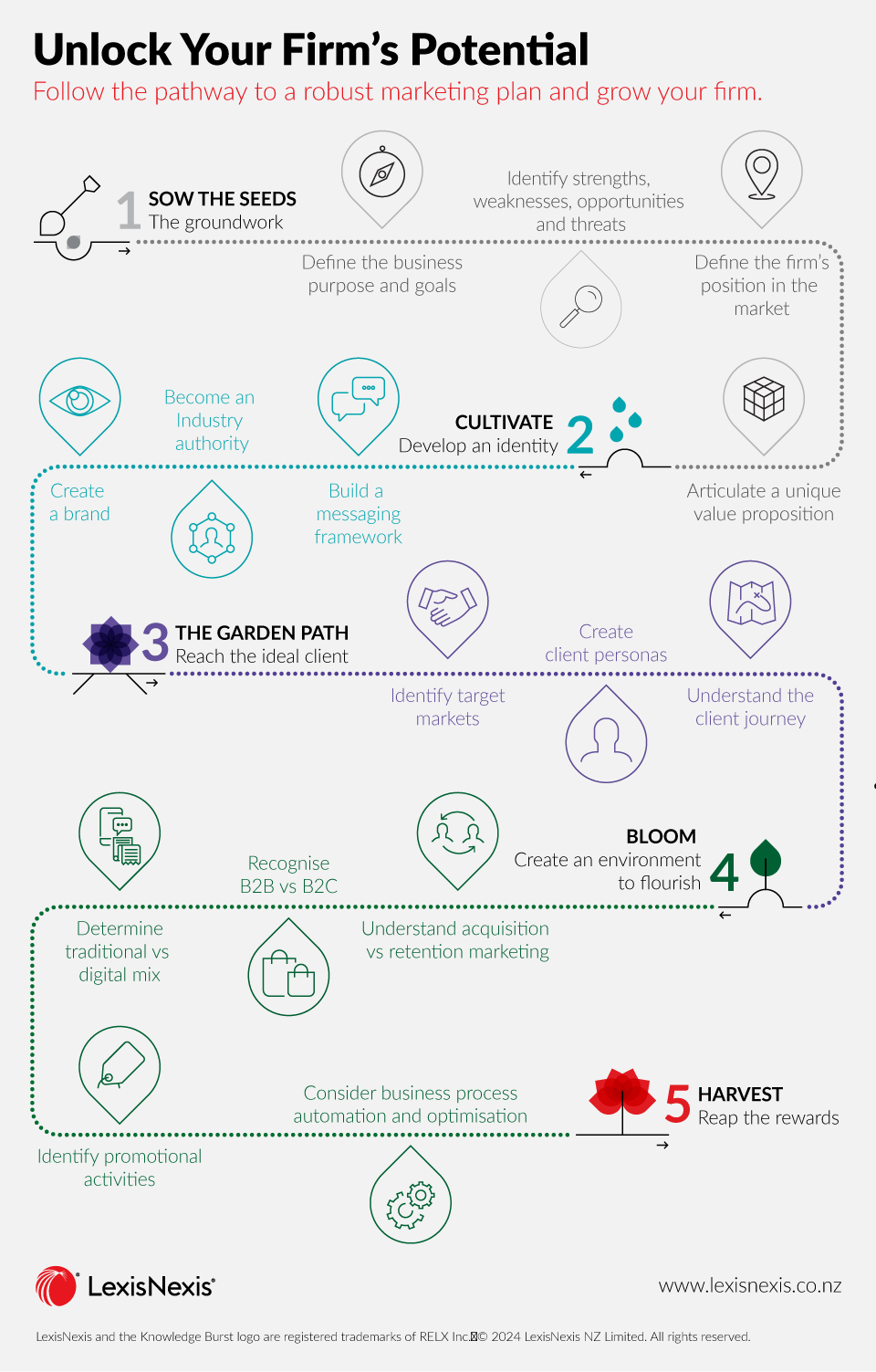Marketing Guide for Law Firms
15 January 2024 13:30
Download the “Marketing Guide for Law Firms”
LexisNexis® Legal Research New Zealand
This eBook is a valuable resource for innovative law firms wishing to improve their marketing efforts and grow their business. It offers an introduction to marketing, examines strategic and tactical components of a marketing plan, and looks at some of the tools and technologies used in modern marketing.
For ambitious law firms, the significance of crafting a robust business strategy and marketing plan cannot be overstated. A well-designed marketing plan can serve as the backbone for a firm’s success by helping to attract new clients, retaining existing clients, elevating brand awareness, and optimising return on investment. We unveil the steps to create a marketing plan that can position your firm on the path to long-term prosperity. Get ready to unlock the true potential of your firm.

Developing a documented marketing strategy and implementing a considered plan are pivotal in maximising long-term marketing success. For a full explanation of each step of the marketing strategy, download the comprehensive eBook Today.
Download FREE Marketing Guide for Law Firms now
Interview with Gerald Chait
A detailed guide to marketing for law firms
You may be a great lawyer, but how well do you market your value? Senior marketing expert reveals top tips for law firm marketing.
Lawyers are known for being well-educated experts in their fields – but when it comes to marketing, many aren’t as confident.
According to Gerald Chait, a highly skilled senior marketing expert with extensive experience in providing marketing services for legal firms, many lawyers find themselves outside their comfort zones when it comes to marketing. It’s not something they learn at law school, and many simply don’t know where to start. But with high levels of competition, it’s not an area that any law firm can afford to ignore.
“The industry is experiencing a level of disruption,” Chait tells NZ Lawyer.
“This is being driven by rapid advances in technology, structural change and increasing competition. The rich traditions and customs of the legal industry are being challenged. Today, marketing is significantly more strategic than simply placing some ads saying ‘we provide this service, call us’ – it’s about creating value for clients and communicating that value to potential clients in a way that no-one else is doing it.”
Differentiating yourself in a crowded market
For Chait, his first experience of the legal industry was when he found himself needing a personal injury lawyer in 2017.
Personal injury is one of the most crowded areas of Australia’s legal market, and finding the right lawyer became an extremely difficult task. This made him realise that while there are many excellent lawyers out there, many of them simply weren’t communicating their expertise and value in a manner that differentiated them and created confidence that they were the best option.
For law firms looking to stand out, Chait says the first step is to look at your business, and understand who you are and what you provide.
“Look at your company, your customers, your competitors, your collaborators, and the climate/external environment in which you’re working,” he explains.
“Then you can articulate your business strategy, mission, unique value proposition, your competitive strengths and your brand positioning. These are some of the drivers that will then inform your advertising and promotions strategy and messaging.”
It is very important that law firms are crystal clear on exactly what value they deliver to clients. For example, it may be functional value like simply helping with a document, economic value such as lower fees, or it might be life-changing value – something which is particularly relevant for areas like injury compensation or family law.
Once this is done, firms should look at who is offering similar services and do a strengths and weaknesses analysis on each. Creating a competitor comparison table can be a helpful guide, and firms can then start working out how to differentiate themselves.
Maximising opportunity for small firms
While global heavyweights might be able to sponsor the All Blacks or release endless television ads, small law firms usually won’t have that luxury.
However, Chait says there is ample opportunity for firms with smaller budgets – they simply need to go about it differently.
“In fact, smaller and more agile firms can often have the advantage with faster decision making, and they might not be as risk-averse,” he notes.
“A smaller firm can absolutely be more laser-focused and still enjoy substantial growth.”
According to Chait, one of the best ways to market yourself as a smaller firm is to identify a niche. The impact of this was demonstrated brilliantly through his work with Advantage Legal, a personal injury compensation firm in Sydney, Australia, that originally worked across a broad range of practice areas.
Chait proposed a bold new strategy that involved zeroing in on a very particular section of the market, and the firm took a leap of faith.
“What we did was niche down into exclusively personal injury, and then niche down further into cyclists,” Chait says.
“For them, it was very daunting to go from a big market into something so niche – but they did it.”
With this newfound focus in place, Chait approached Bicycle NSW on Advantage Legal’s behalf, and offered to become their legal compensation partner to represent members who have had accidents. This was the start of an exceptionally strong relationship, and one of Advantage Legal’s Principal Solicitors has since been elected onto the board of Bicycle NSW.
“They’re now seen as the go-to firm if you’ve had a bicycle accident,” Chait says. “That’s a good case study because it’s not about advertising at all, it’s all about the strategy.”
Marketing methods: the pros and cons
Law firms have a number of options when it comes to their marketing. They can employ external agencies, hire in-house marketing specialists, or lawyers in smaller firms can take a shot at doing it themselves.
Each approach comes with its own advantages and pitfalls. External agencies generally have vast resources at their disposal, as well as a wide range of experts from web developers to copywriters, SEO experts and automation specialists. They can also be more cost effective than having fixed salary costs, and are able to scale up your strategy when required.
“The cons are they might have a lack of in-depth knowledge of your law firm’s specific practice area, and they might not have enough time or scope to learn that in a short time,” Chait explains.
“Coordination and communication will also be more challenging, and you’ll potentially have less control of the day to day execution of strategy. An in-house specialist may have a more in-depth understanding of the business and the practice area, as well as your culture, values, services and target audience.”
Lawyers also have the option of handling marketing themselves – however, Chait warns that this is no easy task. But if they are determined to do it, there are several things they should focus on getting right.
“The key is to promote yourself as an individual expert in a particular field, and that might mean speaking at conferences, attending media events or building a personal online presence,” Chait says.
“It can also involve networking, encouraging online reviews, presenting educational webinars and joining industry associations.”
For law firms looking for marketing guidance, Chait’s eBook offered for free by LexisNexis New Zealand is the best place to start. It provides practical advice on all aspects of law firm marketing, and includes a helpful infographic that provides a step-by-step guide on each stage of the process.
“It’s a high-level path that firms can follow, and it’s a great place to start,” Chait says.
“That information will give you a really solid understanding of the fundamentals, and it’ll give you an idea of how to get started.”
To learn more about marketing for law firms, download Chait’s eBook for FREE by clicking the button below and submitting the form:
 Lexis Nexis
Lexis Nexis 